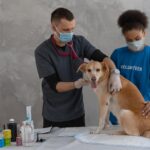Aging is a normal part of life. Like humans, they experience mental and physical changes as they age. Their muzzles become gray as they age and the quality of their coats declines, resulting in hair loss and white hairs on the skin. Their eyes can appear hazy, blue, or pearl-like.
Older cats and dogs develop fat and lose muscle. As they get older, the caloric requirements of their day tend to diminish. Part of this is biological, and a part is because they sleep more and do less. Many elderly pets lack the play and exercise endurance they had in their younger years.
Health Problems in Old Pets
Age can also increase your pet’s chances of developing several health issues. A visit to your veterinarian frequently allows you to assess any changes you’ve seen in your pet and identify any problems before they become more serious. Here are five health issues that are prevalent in older canines.
1. Heart Problems
Older dogs and cats often suffer from heart problems. Cardiomyopathy, a condition involving muscles of the heart, is among the most prevalent cardiac conditions that may affect cats. In dogs, congestive heart failure is a prevalent cardiac illness that impairs the ability of the heart to pump blood. Trouble breathing, coughing, weakness, and vomiting are a few of the signs that are associated with heart disease. Do not hesitate to call your doctor if you notice these symptoms.
You can visit reputable veterinary websites to learn more about how to deal with health problems in pets and how to prevent them.
2. Kidney Issues
The kidneys’ responsibility is to remove waste from the body and keep it balanced. In the body, when the kidneys fail, leading to renal failure. This could be because of natural aging or kidney stones blocking the urinary tract. Kidney stones have been connected to an increase in the consumption of water by your pet and urine production.
Visit a veterinary internist in Ypsilanti if you think your pet has trouble with his kidneys. The early detection of kidney disease may help your pet live a longer and healthier life.
3. Arthritis
In animals, osteoarthritis can be a prevalent source of joint pain. A good diet and therapy may help alleviate the symptoms of arthritis and may also limit its development. It can signify the feeling of being irritated, limping, fear of stairs, trouble standing or walking, licking or chewing at the painful joint, and showing signs of discomfort when picked up. The appropriate therapy to treat joint pain in your pet is to discuss the issue with your veterinarian if your pet displays indications of this condition.
4. Lumps and Bumps
Senior animals could have a higher chance of developing lumps and bumps; however, not all of them are malignant. Be aware of changes in weight, cuts that take a long time to heal, and any changes in bowel habits. Getting an area of growth checked as soon as you see it is recommended.
If you spot any bump on your pet’s body or experience any animal emergency, you should contact the vet as quickly as possible.
5. Dental Issues
Periodontal disease may be prevented by practicing good dental hygiene. It’s possible to detect foul breath, distended drooling gum irritation, or loose teeth if your dog or cat has dental problems. This can also lead to an increase in weight, infection, heart disease, or renal damage. You can ensure that your pet’s dental and gums are healthy as they grow older by going to the vet for regular exams and teaching them good oral hygiene practices.

 Grooming Techniques for a Parasite-Free Pet
Grooming Techniques for a Parasite-Free Pet  Recognizing Vision Loss in Dogs: Signs to Watch Out for
Recognizing Vision Loss in Dogs: Signs to Watch Out for  Preparing Your Pet for Their Yearly Checkup
Preparing Your Pet for Their Yearly Checkup  What Should You Be Aware of Intestinal Parasites?
What Should You Be Aware of Intestinal Parasites?  Why Vaccines are a Must-Have for Your Pet’s Safety
Why Vaccines are a Must-Have for Your Pet’s Safety  4 Techniques for Reducing Kennel Anxiety When Boarding Pets
4 Techniques for Reducing Kennel Anxiety When Boarding Pets  Veterinary Internal Medicine: A Key to Pet Wellness
Veterinary Internal Medicine: A Key to Pet Wellness  Conditions Vaccines for Pets Prevent
Conditions Vaccines for Pets Prevent 